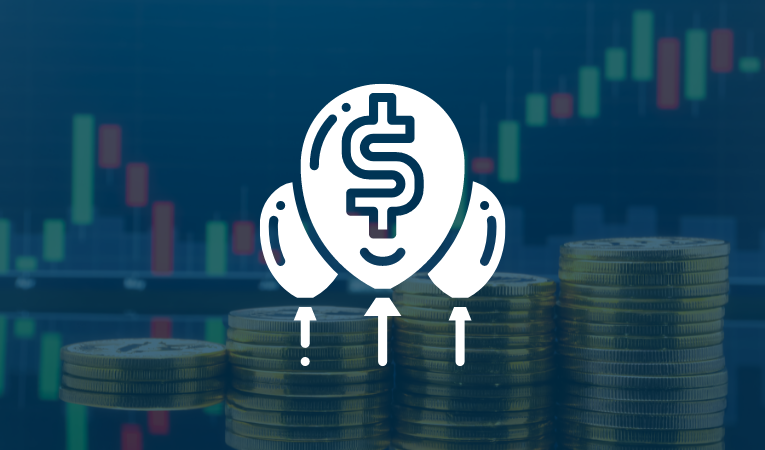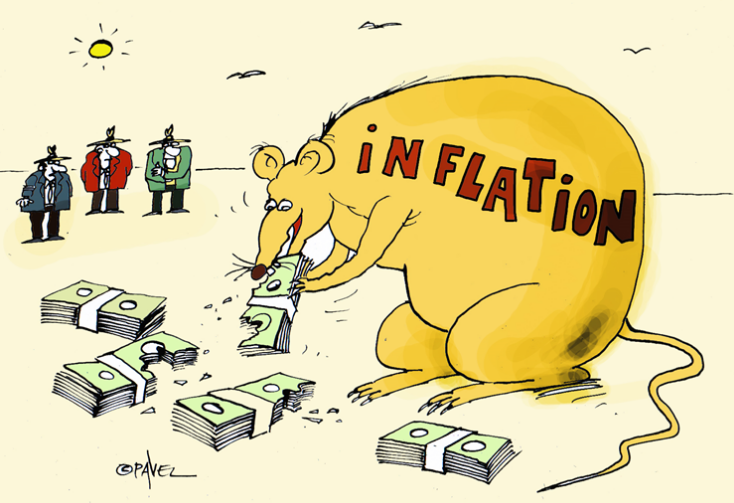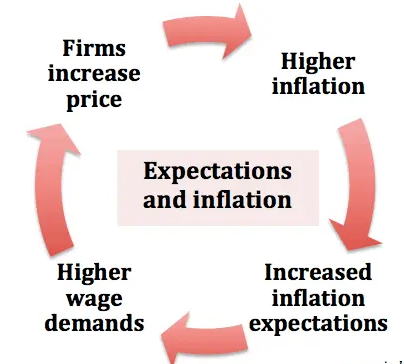Is inflation good or bad for stocks? July 30, 2021

This article is part of a 3-part series on inflation.
In this first part, we look at inflation, its causes and effects, its impact on stock markets and investment portfolios and inflation expectations over the short and long terms.
At a glance:
- Inflation is a general increase in the prices of goods and services. Types of inflation include demand-pull and supply-push inflation.
- Inflation brought about by economic expansion may not be a bad thing. The danger is runaway inflation, which over-heats economies and triggers recessions.
- Inflation typically hurts growth stocks more than value stocks, as the discount on their future cash flows is bigger.
- Current inflation is high due to supply-chain disruptions, pent-up demand during COVID-19 and the base effects of 2020’s economic downturn.
- Longer-term inflation is expected to normalise after the short-term inflationary pressure eases.
Headlines on inflation have been instilling fear in investors. But is inflation a good or bad thing?
There are four main causes of inflation. Some drive inflation for the correct reasons, such as economic growth. If inflation is kept in check, there should be no reason to fear it as it is usually an indicator of steady economic growth.
The current environment may reflect stronger-than expected inflation, which would be a tailwind for value stocks. But once inflation normalises over the longer term, growth stocks are expected to outperform again, thanks to structural shifts in the economy.
Investors may find out more on inflation in our past webinar on ‘Insulating Wealth Against Rising Inflation’ here.
 Fig 1. Inflation eats away money1
Fig 1. Inflation eats away money1
What is inflation?
Inflation is the rate of increase in the prices of goods and services. It can come about from:
- Demand-pull forces: This is known as demand-pull inflation. Strong consumer demand stems from a strong economy that has low unemployment and rising wages. This translates to higher consumer confidence and spending. With higher demand, prices rise.
- Supply-push forces: This is known as supply-push inflation. It occurs when a surge in production costs due to shortages of inputs such as raw materials or labour jacks up the prices of end-products.
- Expansionary fiscal policies: Direct cash transfers to or tax cuts for companies and consumers increase disposable income. With higher purchasing power, companies and consumers spend more, lifting demand.
- Expansionary monetary policies: Lower interest rates encourage borrowing by consumers for spending and companies for investments. This increases money supply, spending and demand in the economy.
Inflation that is brought about by an expanding economy is not necessarily negative for the economy. However, if sustained, inflation will erode the purchasing power of consumers, especially those whose investments are mainly in fixed-return instruments such as bonds. Bonds pay fixed coupon payments. Inflation could cause those investors to buy less than they once did as their investment returns do not change despite higher prices.
A simple example of inflation is a plate of chicken rice that used to cost less than S$3. Today, it can cost anywhere from S$3 to S$5, depending on where you eat your chicken rice.
Runaway inflation occurs when prices rise too fast. This eventually affects the ability of consumers to spend. The drop in demand forces businesses to cut costs and scale down. In rare cases, excessive inflation leads to hyperinflation, when prices spiral out of control. Hyperinflation often occurs in times of economic or political turmoil, when a country’s central bank feverishly prints money to pay for its spending, sending prices higher.
The best-known historical example of hyperinflation was Germany during World War 1. German hyperinflation, at its height, was more than 30,000% a month. The most recent example of hyperinflation is Venezuela in 2018, when prices in the country catapulted 65,000%!
 Fig 2. Self-fulfilling prophecy of inflation expectations
Fig 2. Self-fulfilling prophecy of inflation expectations
You may not be fully aware of this, but inflation expectations heavily influence actual inflation. Expectations can be self-fulfilling. If an economy is expecting inflation to be X%, businesses would want to increase their selling prices by at least X% to maintain the same level of profitability. An increase in inflation or inflation expectations is also usually accompanied by an increase in interest rates. This is because when prices rise, the Federal Reserve in the US would want to raise interest rates in an attempt to maintain price stability. Rates are raised when inflation surges and lowered when inflation drops.
Growth vs. value: Why inflation is good for value stocks
How does inflation affect your portfolio?
As we’ve already pointed out, inflation affects the returns of investors of fixed income. But inflation also affects stocks, more so growth stocks than value stocks.
During inflation, growth stocks tend to perform worse than their value counterparts. This is because growth stocks derive most of their value from their future earnings, which are discounted in a rising-interest-rate environment. Value stocks derive most of their value from their current earnings, with limited discounting of their future earnings.
Furthermore, growth companies are known to take on more debt than value companies to support their rapid expansion. Their higher debt translates to higher interest payable when interest rates rise. This decreases their profitability.
Put together, the higher discounts of future cash flows and higher interest payable affect the value of growth stocks more than value stocks. Thus, in an environment of inflation, a portfolio with more allocation to growth stocks may underperform the one with more allocation to value stocks.
A caveat, though. Value stocks usually pay dividends. The real return of their dividends can be equally eroded by inflation over the longer term.
Inflation in the short term
Fed officials describe the current bout of inflation as transitory, meaning it should go away. They are expecting several months of elevated price increases because of pent-up demand, supply-chain lags and last year’s weak prices when the global economy was largely shut down.
Supply-chain disruptions around the world have two major effects. They lead to limited supply of key components for producing goods. This means producers have to pay a higher price to secure their raw materials. This, in turn, limits the amount of finished goods, which causes demand to outstrip supply.
Both will push up prices. The most obvious example is the current global shortage of semiconductors, which are used to produce anything from cars to handphones.
During COVID-19, many governments also made direct transfers of cash to their citizens to tide them over the crisis. The combination of income support and decreased spending elevated savings rates in the US to 28% in March 2021, much higher than the average pre-crisis saving rate of 7.5%2.
Now that uncertainties from the pandemic are dissipating with vaccinations, consumers are likely to be more confident about spending their disposable income. Pent-up demand following subdued spending during lockdowns has created demand backlogs, especially for discretionary goods and services. This is evident in the current upsurge in air travel in the US, where volume at airport checkpoints is six times higher than a year ago3.
Due to low inflation last year, current YoY inflation numbers are also inflated. Had there been no pandemic, headline inflation this year would have been roughly 2.9%, rather than the reported 4.2%, which is spooking investors4.
Add these factors together and inflation is most likely here to stay in the near term.
Inflation in the long term
Longer term, inflation could normalise once the various influences fade.
One example is the recent jump in wages in the US economy. June’s wage hikes in the US were caused by a shortage of labour supply, despite a high unemployment rate of 5.8% or 9.3mn unemployed compared to a pre-pandemic low of 3.5% when 5.7mn were unemployed5. The wage inflation may be attributed to fiscal support from the government, which might have acted as a disincentive for people to look for jobs when they can live off benefits. When fiscal support ends sometime in early September, wages are likely to return to normal6. Consumer spending may then drop and wage inflation settle down once people start to look for jobs.
The view that inflation will be transitory can be further supported by our simple observation that not all pent-up demand will translate into actual spending. Think of this: a person who used to travel four times a year before the pandemic may not necessarily want to cram in four trips this year, or even next. In his testimony before the US House financial services committee, Fed Chairman Jerome Powell said he believed the current inflation is directly linked to the reopening of the economy. He expects inflation to settle down in the middle or latter part of 2022, when the economy normalises7.
Balancing inflation
Inflationary pressure in the short term has roiled markets. Should inflation stay consistently above estimates, the Fed will be forced to act sooner than later to stabilise prices. This may trigger further corrections in the market.
On the other hand, if inflation is controlled, it can serve to support sustainable economic growth. This is good news for markets. The Fed can be trusted to deploy its arsenal of policy tools to keep inflation within its comfort zone over the longer term. As such, investors should pay close attention to Fed decisions on interest rates for the direction of market movements.
Enjoy what you read? Stay tuned for the next articles in the series!
Reference:
- [1]https://www.cagle.com/pavel-constantin/2013/01/inflation?
- [2]https://www.whitehouse.gov/cea/blog/2021/04/30/new-data-releases-show-the-importance-of-government-support-during-the-pandemic/
- [3]https://www.cnbc.com/2021/06/01/us-air-travel-reaches-pandemic-high-as-peak-season-kicks-off.html
- [4]https://www.forbes.com/sites/georgecalhoun/2021/05/22/the-inflation-figures-are-grossly-inflated–heres-how/?sh=63d87faa2deb
- [5]https://www.bls.gov/news.release/pdf/empsit.pdf
- [6]https://www.fitchratings.com/research/sovereigns/us-core-cpi-inflation-to-rise-further-before-easing-in-2022-28-06-2021
- [7]https://www.fitchratings.com/research/sovereigns/us-core-cpi-inflation-to-rise-further-before-easing-in-2022-28-06-2021
Disclaimer
These commentaries are intended for general circulation. It does not have regard to the specific investment objectives, financial situation and particular needs of any person who may receive this document. Accordingly, no warranty whatsoever is given and no liability whatsoever is accepted for any loss arising whether directly or indirectly as a result of any person acting based on this information. Opinions expressed in these commentaries are subject to change without notice. Investments are subject to investment risks including the possible loss of the principal amount invested. The value of the units and the income from them may fall as well as rise. Past performance figures as well as any projection or forecast used in these commentaries are not necessarily indicative of future or likely performance. Phillip Securities Pte Ltd (PSPL), its directors, connected persons or employees may from time to time have an interest in the financial instruments mentioned in these commentaries. Investors may wish to seek advice from a financial adviser before investing. In the event that investors choose not to seek advice from a financial adviser, they should consider whether the investment is suitable for them.
The information contained in these commentaries has been obtained from public sources which PSPL has no reason to believe are unreliable and any analysis, forecasts, projections, expectations and opinions (collectively the “Research”) contained in these commentaries are based on such information and are expressions of belief only. PSPL has not verified this information and no representation or warranty, express or implied, is made that such information or Research is accurate, complete or verified or should be relied upon as such. Any such information or Research contained in these commentaries are subject to change, and PSPL shall not have any responsibility to maintain the information or Research made available or to supply any corrections, updates or releases in connection therewith. In no event will PSPL be liable for any special, indirect, incidental or consequential damages which may be incurred from the use of the information or Research made available, even if it has been advised of the possibility of such damages. The companies and their employees mentioned in these commentaries cannot be held liable for any errors, inaccuracies and/or omissions howsoever caused. Any opinion or advice herein is made on a general basis and is subject to change without notice. The information provided in these commentaries may contain optimistic statements regarding future events or future financial performance of countries, markets or companies. You must make your own financial assessment of the relevance, accuracy and adequacy of the information provided in these commentaries.
Views and any strategies described in these commentaries may not be suitable for all investors. Opinions expressed herein may differ from the opinions expressed by other units of PSPL or its connected persons and associates. Any reference to or discussion of investment products or commodities in these commentaries is purely for illustrative purposes only and must not be construed as a recommendation, an offer or solicitation for the subscription, purchase or sale of the investment products or commodities mentioned.
About the author
Lee Yong Heng (Dealer) & Roger Chan (Manager)
Yong Heng joined Phillip Securities in June 2020 this year as an Equity Dealer in the Global Markets Team. He specializes in the US and Canada markets assisting clients and also supports the UK and Europe markets. Yong Heng graduated with First Class Honours from Singapore Institute of Management, University of London (SIM-GE) in 2015 with a Bachelor’s Degree in Economics & Finance. He also completed his CFA studies last year.
Roger holds a Business Degree in Electronic Commerce from the Monash University and is also the recipient of the Golden Key Scholarship Award for outstanding academic performance. He currently heads the Global Markets Night Trading team assisting clients with the US and European markets.
Prior to the night desk, he was a bond trader at the Debt Capital Markets desk and brings with him a wealth of equity and debt market knowledge.
Outside work, he trains and is an active competitor in the martial art of Brazilian Jiu-Jitsu. He finishes at the podium frequently and is also the 2015 Pan Asian BJJFP champion. His other interests include chess and reading.

 Back in Business: The Return of IPOs & Top Traded Counters in March 2024
Back in Business: The Return of IPOs & Top Traded Counters in March 2024  From $50 to $100: Unveiling the Impact of Inflation
From $50 to $100: Unveiling the Impact of Inflation  Japan’s Economic Resurgence: Unveiling the Tailwinds Behind Nikkei 225’s Record Leap
Japan’s Economic Resurgence: Unveiling the Tailwinds Behind Nikkei 225’s Record Leap  How to soar higher with Positive Carry!
How to soar higher with Positive Carry! 









